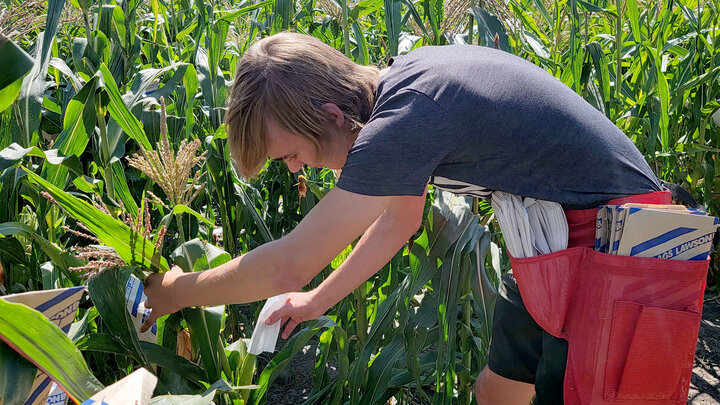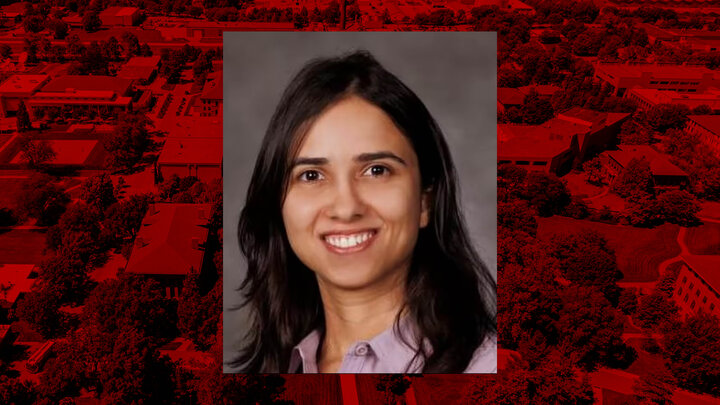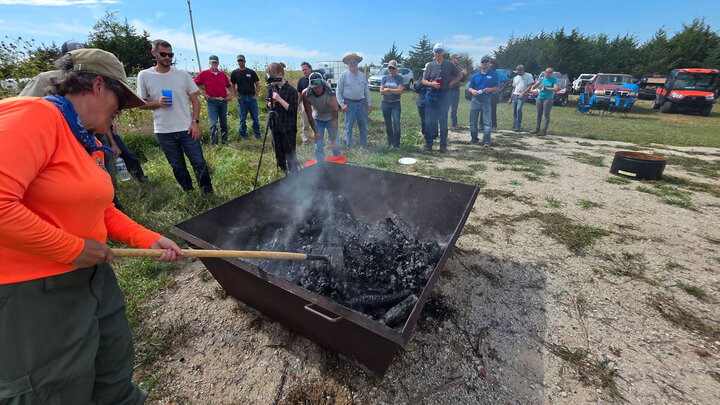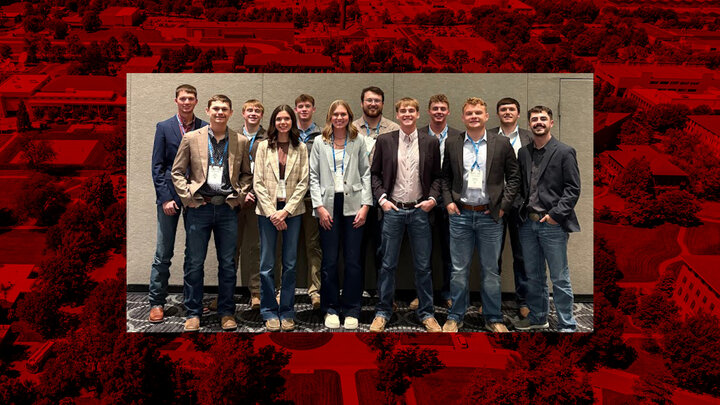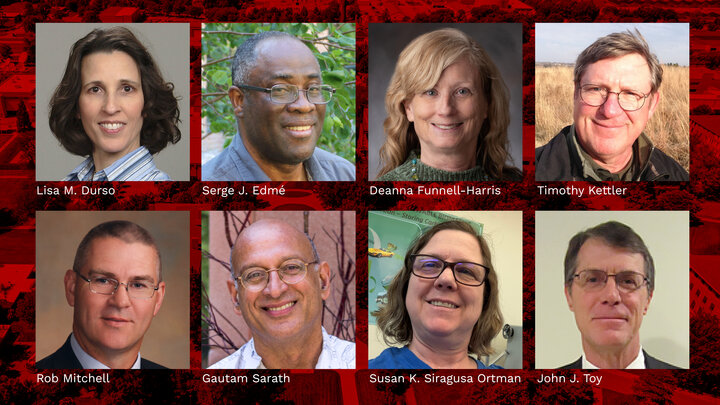Five Department of Agronomy and Horticulture students are among 175 Husker undergraduates awarded stipends by the University of Nebraska–Lincoln to participate in research with a faculty mentor this summer.
Nebraska’s Undergraduate Creative Activities and Research Experience (UCARE) Program supports undergraduates to work with faculty mentors in research or creative activities. Students receive stipends of $2,400 to engage in intensive research or creative activity for 20 hours per week. The students’ projects span academic disciplines.
Lydia Regier, a junior plant biology major from Lincoln, Nebraska, is working with research mentor Brian Wardlow, a professor of natural resources and Director of the Center for Advanced Land Management Information Technologies. The title of her project is “Detecting the Invasion of Old World Bluestem (Bothriochloa spp.) in Kansas and Nebraska Grasslands via PlanetScope and Sentinel-2 Satellite Imagery.”
“This program has shown me what doing natural resource remote sensing work is like and given me exposure to all the different ways satellite imagery can be used to analyze the natural world,” Regier said.
All or most of Regier’s research is being conducted in a computer lab in Hardin Hall on East Campus. With the nature of this project, it wasn’t necessary for Regier to make any ground truth trips to her study site.
Each day Regier works on the project, she essentially uses Planet and Sentinel-2 satellite imagery to detect Old World Bluestem grass invasion in the study site. Although this study site is located just outside of Hays, Kansas, her work is entirely remote and she relies on spectral signatures picked up from imagery to discern Old World Bluestem from native or other grasses as well as other land cover types like crops, water, human-made structures, forests, etc.
“Most of this work is done on ENVI software with both true-color as well as NDVI-adjusted images,” she said. “Since the work is remote and quite asynchronous, it’s hard to give a true rundown of each day because it varies quite a bit. I’m usually focused on running different iterations of imagery through classifiers or changing classification schemes/settings.”
“It has given me a better understanding of what research is like, which is really beneficial because soon I will be applying to graduate schools,” Regier said.
Benjamin Janssen, a junior plant biology major from Marquette, Nebraska, is working with research mentor John Guretzky, an associate professor of grassland systems ecology in agronomy and horticulture. The title of his project is “Floral Survey of the Boundary Between Central Nebraska Loess Hills and Central Loess Plains in Hamilton County, Nebraska.”
Most of Janssen’s work is being done in the northern section of Hamilton County Nebraska. In June, Janssen did fieldwork in local remnant prairies, and in July, he entered and analyzed survey data, collected specimens and worked on his final project preparations.
“The UCARE program has helped me see what it’s like to consistently do fieldwork for a project,” Janssen said. “It has sharpened my plant ID skills. It has helped me understand how alone one might be when doing field work all day. This helps me understand how I should tailor my career path so I can work with people more often in my future career.”
Lydia Regier, a junior plant biology major from Lincoln, works remotely on her research project in Hardin Hall on East Campus by using satellite imagery to detect Old World Bluestem grass invasion in the study site.
Benjamin Janssen, a junior plant biology major from Marquette, Nebraska, walks back from a floral survey plot at Gjerloff Prairie in Hamilton County Nebraska.
Cleopatra Babor, a junior plant biology major from Naperville, Illinois, slowly pulls the tassel from its protective bag while cross-pollinating corn in professor David Holding's research plots on East Campus. Craig Chandler | University Communication & Marketing
Abigail Ridder, a senior plant biology major from Logan, Iowa, conducts a seedling survey in the Nature Conservancy’s Niobrara Valley Preserve. The research plot is part of the Smithsonian ForestGeo program.
Cleopatra Babor, a junior plant biology major from Naperville, Illinois, is working with research mentor David Holding, a professor of plant molecular genetics in agronomy and horticulture. The title of her project is “Breeding Colored and Quality Protein Popcorn and Sweet Corn Varieties.”
Depending on the weather, most days Babor starts off monitoring popcorn and sweet corn plant development and field conditions on East Campus. After fieldwork, she moves to Holding’s lab at the Beadle Center to work on tasks that help to determine her breeding project’s next steps. She works with technologists Jonathan Niyorukundo, an agronomy graduate student, and William Anderson, a freshman.
“This program has given me support to work on research at an undergraduate level,” Babor said. “This opportunity provides me with experience in a research setting that I will be able to use in my future career.”
Anderson, a freshman plant and landscape systems major from Gothenburg, Nebraska, is also working with Holding as his research mentor. The title of his project is “Diversifying Nebraska Agriculture and Education through Breeding Sweet Corn and Popcorn with Novel Nutritional, Taste and Aesthetic Characteristics.”
For Anderson, every day can be different depending on where the corn is in its maturity. His research is split evenly between the field and lab.
“Later on, as we start to identify some traits within particular plants, we will transition to the greenhouse and do more targeted crosses,” he said.
Early in his research, his days consisted of taking samples from different plants, extracting DNA and then using a handful of different primers to find which one worked best. He helped hand-weed the field during this time as well. The next step was pollination, where the group — Anderson, Babor and Niyorukundo — would go out every morning and either self-pollinate the corn or cross-pollinate two different lines.
“We're now just starting the process of harvesting a lot of our sweet corn ears and then scoring them based on performance in color, sweetness and texture,” Anderson said. “Four of the ears are then taken back to the lab where we flash freeze them and store the kernels for later analysis.”
Anderson believes the UCARE program has helped his future career in the industry.
“It has put me into contact with so many other great faculty and students which is really nice,” he said. “In the future, I would like to continue to do research and lab work with plants, so being exposed at such an in-depth level this early on has proved invaluable.”
Abigail Ridder, a senior plant biology major from Logan, Iowa, is working with research mentor Sabrina Russo, a professor of biological sciences. The title of her project is “Evaluating Eastern Redcedar Recruitment Success in the Niobrara River Valley.”
“This UCARE project has shown me how the world of research works,” Ridder said. “I have learned a lot about organizing and planning fieldwork as well as understanding scientific literature. It has also helped me build my communication and writing skills.”
Ridder is conducting a seedling survey of a 360- x 550-meter research plot separated into 504 quadrats. This is being conducted in the Nature Conservancy’s Niobrara Valley Preserve and the research plot is part of the Smithsonian ForestGeo program, which is a global network of research forests. Depending on the day, Ridder is accompanied by one to three lab technicians in the field.
“The data I am collecting involves identifying and evaluating woody seedlings in one square meter of each of the 504 quadrats within the plot,” Ridder said. “Every day our team will find the survey location within a quadrat, estimate plant cover within the square meter, and identify/tag every woody seedling within the square.”
Students from the Nebraska Summer Research Program and UCARE will present posters on their research and creative activities at a campus research symposium 10 a.m. to noon on Aug. 5 in the Centennial Room and Ballroom in the Nebraska Union.
For more information on undergraduate research at Nebraska, click here.
